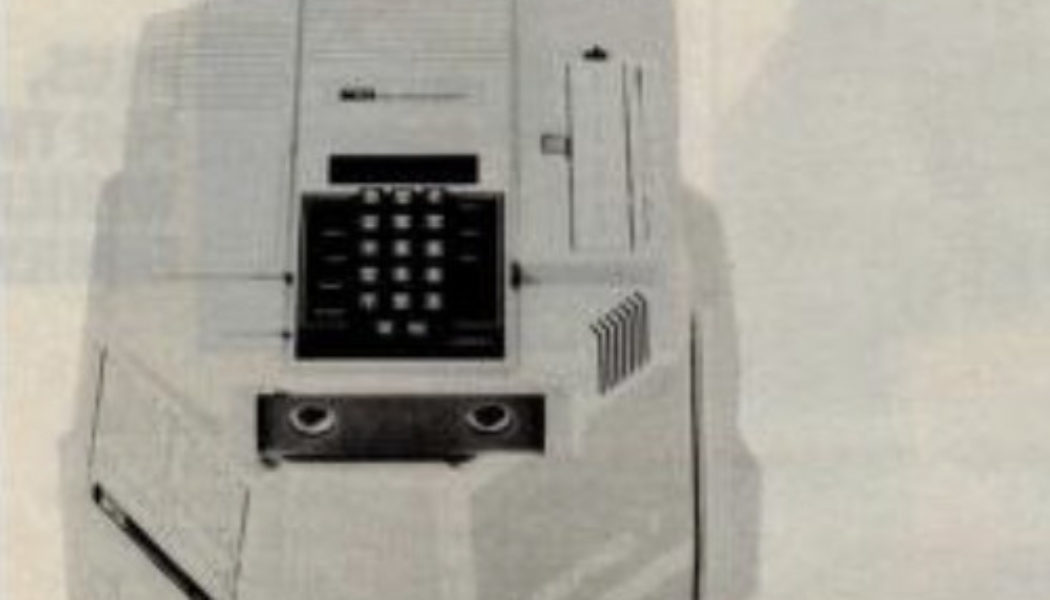Amazon announced its Astro home robot on Monday, which is designed to be an Alexa on wheels that can also bring you stuff (if other people load it into the cargo bay) and act as a sort of guard dog. With a touchscreen for a face and the ability to move itself around a single story of your house, it’s a bit like the personal robots from decades of science fiction. Given that Amazon seemingly wants to continue making home robots, though, we figured we’d go through a little history to look at some previous attempts.
Of course, there’s plenty of discussion to be had about what does or does not count as a robot — to anyone with a smart home setup, Siri, Alexa, and Google Assistant could be considered robots, as they can do any number of tasks if you buy the necessary hardware. But for this list, we’re going to look at things that are either billed specifically as household robots or are robots that we’d really love to invite into our homes.
:no_upscale()/cdn.vox-cdn.com/uploads/chorus_asset/file/22888567/Screen_Shot_2021_09_29_at_2.16.53_PM.png)
HERO
Release year: 1982
What it could do: Teach you what it’s like to build a robot
The HERO, which stands for Heath Educational Robot, was a massive tank of a machine that was designed to be, as the name suggests, an educational tool. It came as a kit (though you could also get it pre-built), and most of its utility came from what you learned putting it together. I’m not going to do an Ahoy-style research journey to prove that it was absolutely the first home robot that ever went on sale, but being from the 1980s, it definitely came in on the ground floor. The decade would later see a variety of other home educational robots similar to the HERO.
[embedded content]
According to a Byte magazine article from the time, it could talk, be controlled with a remote, and could even pick up a beverage — that is, after you assembled the add-on mechanical arm, which the author says took 10 hours. Does that make it more useful than what Amazon just announced in 2021? I guess that’s up for you to decide. You can watch a demo of the Hero Jr., a successor to HERO, here.
:no_upscale()/cdn.vox-cdn.com/assets/4168313/ROB_test_unit.JPG)
Nintendo R.O.B.
Release year: 1985
What it could do: Sell NESs
When Nintendo went to sell its Family Computer in the US, it had a problem: video games were about as attractive to most consumers as toxic waste, as the industry had more or less just imploded. Its solution was to instead market the console as a toy, calling it the Nintendo Entertainment System and including a robotic pal named Robotic Operating Buddy. R.O.B was a big part of much of Nintendo’s early marketing for the NES, making potential customers look and say, “Wow, what can that do?”
The answer was that it could move gyroscopes and plastic tokens around to let you play all of two games. R.O.B. turned out to be better at making kids want an NES than helping them play it — some commenters have said that playing games designed for it is more fun if you have another human press the controller’s buttons on the controller instead of the bot. The fact that it wirelessly received signals from the TV was pretty neat, though, and the NES did pretty well for itself. So despite not having the robot servant capabilities that its looks implied, maybe R.O.B. did everything it needed to.
Aibo
Release year: 1999
What it could do: Fill my heart with warmth
Sony’s Aibo was a late-90s robotic pet dog, which was designed to be more of a companion than a servant. And it is, at least in my opinion, probably the cutest home robot. According to the user manual uploaded to an Aibo fansite (PDF), Aibo’s personality would change as it got older, and how it behaved as an adult would differ depending on how you treated it. Sony also claimed that Aibo would play and run around your house if you raised it right — otherwise, it’d be like my non-robotic cat and just nap all day.
Some people and families formed an actual emotional connection with Aibo, like they would with a biological pet. There are genuinely sad stories of people who held funerals for their robot dogs, which broke down after Sony stopped fixing them. Yes, it does seem like something out of Do Androids Dream of Electric Sheep, but you try living with something that looks and acts like a dog for years without falling in love with it.
Okay, no, Sega’s iDog doesn’t count, because all it really did was kinda dance to music and get moody (shoutout to my childhood friend who had the iFish, by the way).
There have been several iterations of Aibo over the years, along with attempts at robotic pets by other companies. Sony announced a new version of Aibo in 2017 and appears to still be selling it — though the website said there was only one left in stock when I looked.
:no_upscale()/cdn.vox-cdn.com/uploads/chorus_asset/file/2797238/roomba-880-hands-on3_2040.1384228987.jpg)
Robot vacuums
Release year: 2001, first Roomba introduced in 2002
What it can do: Clean your floors and freak out bio-Aibos (dogs)
Companies have been envisioning self-controlled vacuums for decades, but one of the first ones you could actually buy was the Electrolux Trilobite, which was released in 2001. It was made by a huge name in high-end vacuums but was upstaged the next year with the introduction of the iRobot Roomba. The robotic floor-cleaners were basically primitive versions of the ones we have today — they’d bump around your room until the floors were clean. We’ve also seen plenty of variations on that same concept, with companies introducing robots that mop hardwood floors and even mow your lawn.
Arguably, robot vacuums (and other single-purpose automated machines) are the most successful home robots we’ve seen so far. While they can still struggle in hilarious ways, they’ve come a long way since the Trilobite, and some models are even able to empty themselves. That’s not even mentioning the various ways people hack into or strap things onto their robot vacuums to make them more useful.
:no_upscale()/cdn.vox-cdn.com/uploads/chorus_asset/file/22889165/homepage_section5.jpg)
Paro
Release year: 2004
What it can do: Provide emotional support
Paro is a robotic baby seal that was designed to act as a sort of therapy for people in elderly care or for people who otherwise need emotional support. It makes seal sounds, can move, and even charges with a cable shaped like a pacifier. In other words, it’s exceedingly cute and has been used in nursing homes as an alternative to real-life animals for pet therapy, according to The Wall Street Journal. Paro isn’t going to bite anyone or cause an allergic reaction, and it doesn’t need to be fed anything except electricity.
There have been debates about whether robots should have such a role in elder care, and whether they may take the place of human relationships. But as someone who is frequently distressed, I would love to have one of these to hug (though, given Paro’s multi-thousand dollar price tag, I may have to settle for the Qoobo, a robot pillow with a tail).
:no_upscale()/cdn.vox-cdn.com/uploads/chorus_asset/file/6930569/DSC01589__1_.0.jpg)
Pepper
Release year: 2014
What it was supposed to do: Understand your emotions
Pepper ended up being mainly used as a billboard and a way to greet people in shops and airports (or the Smithsonian), but when it was announced by Softbank, it was pitched as a robot able to understand human emotions and take care of babies. Physically, it had actual arms and wheels to move around with, as well as a screen that it could use to display things like its name or info about Softbank’s latest phone plan.
It wasn’t particularly successful at connecting with people on an emotional level and certainly didn’t live up to some of the ads that depicted it comforting someone who’s crying — perhaps it was just too ambitious too early, or maybe it was just too dystopian to keep around. Softbank stopped making Pepper earlier this year.
:no_upscale()/cdn.vox-cdn.com/uploads/chorus_asset/file/16214083/akrales_190423_3384_0344.jpg)
Jibo
Release year: Sold on IndieGoGo in 2014, arrived in 2017
What it could do: Dance
The crowdfunded Jibo robot may be one of the most loved home robots, despite the fact that it didn’t actually do a lot. It was meant to be a “social” robot that would greet you by name and that you could have conversations with. What it actually did best was dance with its little robot body (including when it was announcing its own death) and hem and haw about whether climate change is real. Despite that, there are still those trying to keep Jibo alive after its original makers sold it in 2020.
:no_upscale()/cdn.vox-cdn.com/uploads/chorus_asset/file/6564667/ASUS_Zenbo_3.0.jpg)
Asus Zenbo
Release year: Didn’t make it to the US, announced in 2016
What it could do: Control your smart home and basically act like a tablet that can follow you
Zenbo was announced as a $600 robot with many of the same features that Astro is promising today — Asus said it could act as a security guard, contact people for help in case of a fall, and display recipes and videos on its face. It proves difficult to actually find evidence of it existing though — there are no eBay listings for it, and Asus’s support site doesn’t seem to remember the Zenbo.
I did find evidence that Asus actually released this product in the form of an unboxing video from Malaysia, but it’s not easy to get your hands on — Asus’s Zenbo website directs you to contact the company’s sales team if you want to purchase the robot’s education and health-focused successors, the Zenbo Juniors I and II.
:no_upscale()/cdn.vox-cdn.com/uploads/chorus_asset/file/13376877/vpavic_181101_3065_0087.jpg)
Anki Vector
Release year: 2018
What it could do: Make faces at you as it explored your desk
The Anki Vector was a follow-up to another toy robot, the Cozmo. You could get it to play games with you, dance along to your music, and express various emotions with its eyes. Like Jibo, it also had a built-in voice assistant, and also like Jibo, that voice assistant was just OK. But dang, was Vector cute, as it drove around your desk, moving its little forklift arm. The company that created it went out of business, but you can buy a home server to keep it running from another company that took over Anki’s assets.
:no_upscale()/cdn.vox-cdn.com/uploads/chorus_asset/file/13672985/FoldiMate_with_folded_items.jpg)
Foldimate
Announced year: 2018
What it can do: fold your clothes
There were two robots that promised to fold your clothes at CES 2018, and neither of them really worked. In 2019, though, Foldimate returned with a working prototype that could actually fold a shirt in about five seconds. Is that worth the estimated $1,500 to $2,000 pre-order price that Foldimate lists on its website? I guess it depends on how many clothes you fold. Either way, the machine isn’t out yet (and even its design doesn’t seem particularly nailed down), so you may be stuck folding your laundry by hand for a while longer. Bummer!
:no_upscale()/cdn.vox-cdn.com/uploads/chorus_asset/file/22889020/top_img_03.jpg)
Lovot
Release year: 2020
What it can do: accept your love
Lovot may be the most human robot of all because it’s mainly designed to feel needed — according to its creators, it “won’t do any of your work” and “begs for attention and gets in the way of those it lives with.” To help it achieve its purpose of obtaining all your affection, it has wheels, cameras, and microphones that it can use to recognize people and steer itself towards them. In that way, it’s a little like Astro, where it’ll follow people around — but instead of sticking a camera in their face, it’s just asking for them to pick it up and hug its soft body. You can also tickle it to make it fall asleep, and sorry I can’t write any more about it because I’m trying to figure out how to buy one in the US.
:no_upscale()/cdn.vox-cdn.com/uploads/chorus_asset/file/16223219/mira_robotics_ugo_1.jpeg)
Ugo
Release year: 2020
What it can do: act as a remote set of arms
The Ugo is a home robot, but not in the traditional sense that we may think of one. Instead of having an advanced AI robobrain, it just has a human controlling it, like a more functional version of the iPad-on-wheels telepresence robots. The human is able to move the robot, as well as operate its arms by using a pair of VR-style controllers.
The Ugo was originally pitched as a butler, either for the elderly or for families who don’t have time for housework. The World is One News reports that companies have also rented the Ugo to help sanitize buildings during the pandemic. It remains to be seen if it’ll actually be particularly helpful — in the past, a hotel that had robots do various tasks like carry luggage and check in customers found that the system actually created more work for human employees, instead of making their lives easier.
:no_upscale()/cdn.vox-cdn.com/uploads/chorus_asset/file/19550608/MarsCat___10_min.jpg)
MarsCat
Release year: 2021(?)
What it can do: Be a cat
The MarsCat is like a cat version of the Aibo, and its Kickstarter launched in late 2019. Its makers, a company called Elephant Robotics, say that the robokitty will play with cat toys, accept scratches, and respond to commands like “come here.” You should also be able to program MarsCat yourself if you want, as its brain is a Raspberry Pi.
The latest update on the MarsCat’s Kickstarter page is from earlier this month and says that the cats have shipped, though there are only two commenters who claim to have gotten one (and one says theirs is broken).

Bot Handy
Announced in: 2021
What it’s supposed to do: Decorate my home with flowers
At CES this year, Samsung showed off its Bot Handy robot, which looks a bit like an oscillating fan with a robotic arm. The bot brought the presenter a drink of water, something that the Astro can’t do by itself. Samsung also showed it using that arm to put dirty dishes in a dishwasher, and a towel in a laundry basket. Samsung said that the Bot Handy was “in development,” but it’s an extraordinarily ambitious concept — for it to work like Samsung’s demo, it would need lots of abilities that don’t really exist yet, so it’s not likely this particular bot will make it into our homes. Speaking of…
:no_upscale()/cdn.vox-cdn.com/uploads/chorus_asset/file/22794095/robotics_1.jpeg)
Tesla Bot
Announced in: 2021
What it’s supposed to do: Usher in luxury space communism by replacing labor
Earlier this year, Elon Musk got up on stage and said that Tesla was working on a humanoid robot that it would build at some point in 2022. He showed it off by having someone dressed as the robot come out and dance and, after the awkwardness, announced “obviously that was not real” (I’m not sure anyone was fooled).
Musk did promise that the bot will be real at some point, and Tesla says that it’ll be a “general purpose” robot, which will be able to carry out “unsafe, repetitive, or boring” tasks. Is that a realistic vision for next year? I’m laughing too hard to answer. If only I had a robot to bring me a glass of water.









